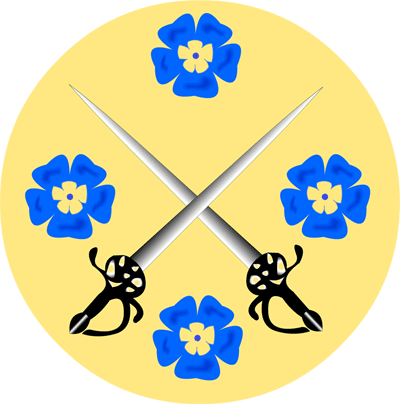Anatomy for Duelists
(or Does this hurt?)
Human physiology is a complicated subject. That’s why doctors spend years in school and then tell you to take 2 aspirin and call them in the morning. Actually this missive will hopefully provide the basic anatomy lesson that all fighters should have.
Starting at the top, you know, that big round thing you stick inside your mask, is your head. A good blow to the head is generally considered fatal or at least incapacitating. There are so many blood vessels in your face that even a light cut to the forehead would be disabling. You couldn’t see your opponent because of the blood. Nicks to the chin, cheek, or nose would be painful, but not incapacitating. Throughout this article, I am primarily discussing real thrusts to the body. Flesh wounds to the face, shoulders, torso, legs, etc. are in general painful, but not immediately deadly. Remember flesh wounds when we discuss blood loss at the end of this missive. A last note on the head, a standard convention is that you treat your mask as if it is your face.
Your neck is just as vulnerable as your face. In fact, any thrust to the neck should be considered deadly. If it didn’t cut your jugular artery, then it punctured your windpipe or cut the muscles that keep your head erect. In either case, you’re feeling lousy.
Your shoulders do more than provide a place for your arms to hang. The muscles in your shoulders allow you to lift you arms, and hold your head up. A thrust or draw cut to the top of the shoulder will not only disable you arm, but your head will tend to flop over on the other side. If you were leaning forward, the rapier went through your collar bone, giving you a punctured lung. At best, a shoulder shot will only disable an arm.
Speaking of lungs, what about your torso. Yes, obviously, a thrust to the lungs or heart will be a kill. But what about the stomach, intestines, or other internal organs. While a shot to these might not be immediately fatal, these are the most painful of injuries. You would be unable to continue purely due to the agony. And anyway, with a typical gut wound, you will die in three weeks of peritonitis.
Draw cuts to the ribs or underarm are also not fatal. However, many muscles were severed with that cut. A draw cut along your ribs would be excruciating. A light scratch might be painful, but not debilitating, but a real draw cut would probably put you out of action.
Draw cuts to the underside of the arm are fatal. Your brachial artery is located there. A draw cut there will cause almost instant shock, and death very shortly thereafter.
Draw cuts to the inside of the leg are also fatal. The femoral artery is just inside your thighs. A thrust to the inner thigh should be treated as a kill as well, not just a leg wound.
Speaking of leg wounds, lets set the record straight now. If you have a leg wound, you will be on your knee (note singular form). You would want to keep as much pressure off you injured leg as possible. So if you are on the ground, either put your weight on your good leg, or sit on your rump. Incidently, people with leg wounds do not leap at their opponents.
On a final note, blood loss is difficult to determine from minor wounds. There are many accounts of real duels being stopped because one of the opponents fainted due to blood loss. If you have received a non-fatal wound, ask yourself, “How much blood have I lost, and how long can I stand the pain?” Please understand, we are coldly fighting a duel, not raging with bloodlust in the middle of a battle capable of ignoring severed limbs. Fighters who yield a bout because of injuries sustained are generally considered the most honorable, and respected in the kingdom.
Lord Kirk Dragomani
Provost, Ad’E
